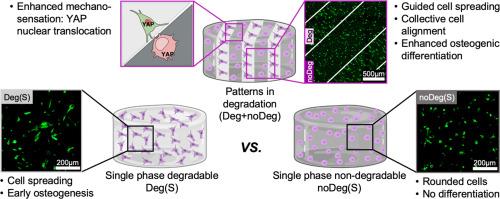各向异性水凝胶降解增强三维间充质间质细胞排列,机械转导和成骨分化。
IF 9.6
1区 医学
Q1 ENGINEERING, BIOMEDICAL
引用次数: 0
摘要
组织工程涉及组装细胞和模仿生物组织复杂的各向异性结构来执行特定功能。本研究使用具有RGD结合基序的三维海藻酸盐基水凝胶,探索与单相材料(单组分:Deg或noDeg)相比,图案水凝胶(两组分:可降解(Deg)和不可降解(noDeg))的各向异性降解对细胞扩散、集体排列、机械转导和被包裹的人间充质基质细胞(hMSCs)成骨分化的潜力的影响。通过光刻技术形成了Deg和noDeg亚区空间格局:紫外线触发的硫醇烯与基质金属蛋白酶(MMP)敏感肽形成Deg相,而非紫外线暴露区域导致diols - alder自发点击交联和noDeg相。水凝胶降解中的3D模式增强了hMSC的扩散,并允许Deg区域的细胞集体排列,而noDeg区域的细胞保持圆形,没有排列。此外,与单相材料相比,我们观察到增强的成骨分化,因为在各向异性凝胶中,中期成骨标志物(骨钙素)在第14天表达,而在单相中,只发现早期成骨标志物(骨质)。利用YAP的表达和定位来评估机械传感途径。与单相Deg材料和noDeg切片相比,图案材料的Deg切片具有增强的核易位和更高的YAP表达。当使用MMP-scramble肽或无rgd材料时,这种效应消失,YAP的表达和定位没有模式。这些发现表明海藻酸盐水凝胶降解的3D模式引导hMSC扩散,集体排列,增强YAP核易位和成骨分化。三维水凝胶模拟组织各向异性在生物制造和组织工程中具有广泛的应用前景。意义说明:图案材料在单一材料中集成了多种特性,密切模仿组织中的各向异性。这项研究进一步证明了负载细胞的水凝胶的各向异性降解如何导致力学中的新模式。因此,与单相材料相比,在3D图案材料中观察到各向异性的hMSC形态和集体取向。此外,我们显示增强和空间引导hMSC成骨分化在图案材料。此外,通过YAP/TAZ信号传导的各向异性机械传感被证明可以介导这种增强的空间引导的机械传导和成骨分化。最后,我们探讨了额外的生化刺激如何进一步促进空间引导的hMSC成骨分化。这些发现促进了我们对各向异性微环境中细胞反应的理解,在生物制造和组织工程中具有广泛的应用。本文章由计算机程序翻译,如有差异,请以英文原文为准。

Anisotropic hydrogel degradation enhances 3D collective mesenchymal stromal cell alignment, mechanotransduction and osteogenic differentiation
Tissue engineering involves assembling cells and mimicking the complex anisotropic architecture of biological tissues to perform specific functions. This study uses 3D alginate-based hydrogels with RGD binding motifs to explore the impact of anisotropic degradation of patterned hydrogels (two components: degradable (Deg) and non-degradable (noDeg)) compared to single-phase materials (one component: Deg or noDeg), on the potential of enhancing cell spreading, collective alignment, mechanotransduction and osteogenic differentiation of encapsulated human mesenchymal stromal cells (hMSCs). Spatial patterns of Deg and noDeg subregions are formed by photolithography: UV-triggered thiol-ene crosslinking with matrix metalloprotease (MMP) sensitive peptides form Deg phases, while non-UV exposed regions result in Diels-Alder spontaneous click crosslinking and noDeg phases. 3D patterns in hydrogel degradation enhance hMSC spreading and allow collective cell alignment in Deg areas, while cells remain rounded with no alignment in noDeg regions. In addition, we observe a boosted osteogenic differentiation when compared to single-phase materials, as mid osteogenic markers (OOsteocalcin) are expressed at day 14 in anisotropic gels, whereas in single-phase only early osteogenic markers are found (OOsterix). Mechanosensing pathways were evaluated using the expression and localization of YAP. Deg sections in patterned materials have an enhanced nuclear translocation and higher YAP expression compared to single-phase Deg materials and noDeg sections. This effect is lost and no patterns in YAP expression and localization emerge when using an MMP-scramble peptide or no-RGD materials. These findings demonstrate that 3D patterns in alginate hydrogel degradation guide hMSC spreading, collective alignment, enhance YAP nuclear translocation and osteogenic differentiation. Mimicking tissue anisotropy in 3D patterned hydrogels could have broad applications in biofabrication and tissue engineering.
Statement of significance
Patterned materials integrate multiple characteristics within a single material, closely mimicking the anisotropy found in tissues. This research goes further by demonstrating how anisotropic degradation of cell-laden hydrogels leads to emerging patterns in mechanics. As a consequence, anisotropic hMSC morphology and collective alignment are observed in 3D patterned materials compared to single-phase counterparts. Additionally, we show enhanced and spatially guided hMSC osteogenic differentiation in patterned materials. Furthermore, anisotropic mechanosensing via YAP/TAZ signaling is shown to mediate this enhanced and spatially guided mechanotransduction and osteogenic differentiation. Finally, we explore how additional biochemical stimuli can further boost the spatially guided hMSC osteogenic differentiation. These findings advance our understanding of cell response in anisotropic microenvironments, with broad applications in biofabrication and tissue engineering.
求助全文
通过发布文献求助,成功后即可免费获取论文全文。
去求助
来源期刊

Acta Biomaterialia
工程技术-材料科学:生物材料
CiteScore
16.80
自引率
3.10%
发文量
776
审稿时长
30 days
期刊介绍:
Acta Biomaterialia is a monthly peer-reviewed scientific journal published by Elsevier. The journal was established in January 2005. The editor-in-chief is W.R. Wagner (University of Pittsburgh). The journal covers research in biomaterials science, including the interrelationship of biomaterial structure and function from macroscale to nanoscale. Topical coverage includes biomedical and biocompatible materials.
 求助内容:
求助内容: 应助结果提醒方式:
应助结果提醒方式:


